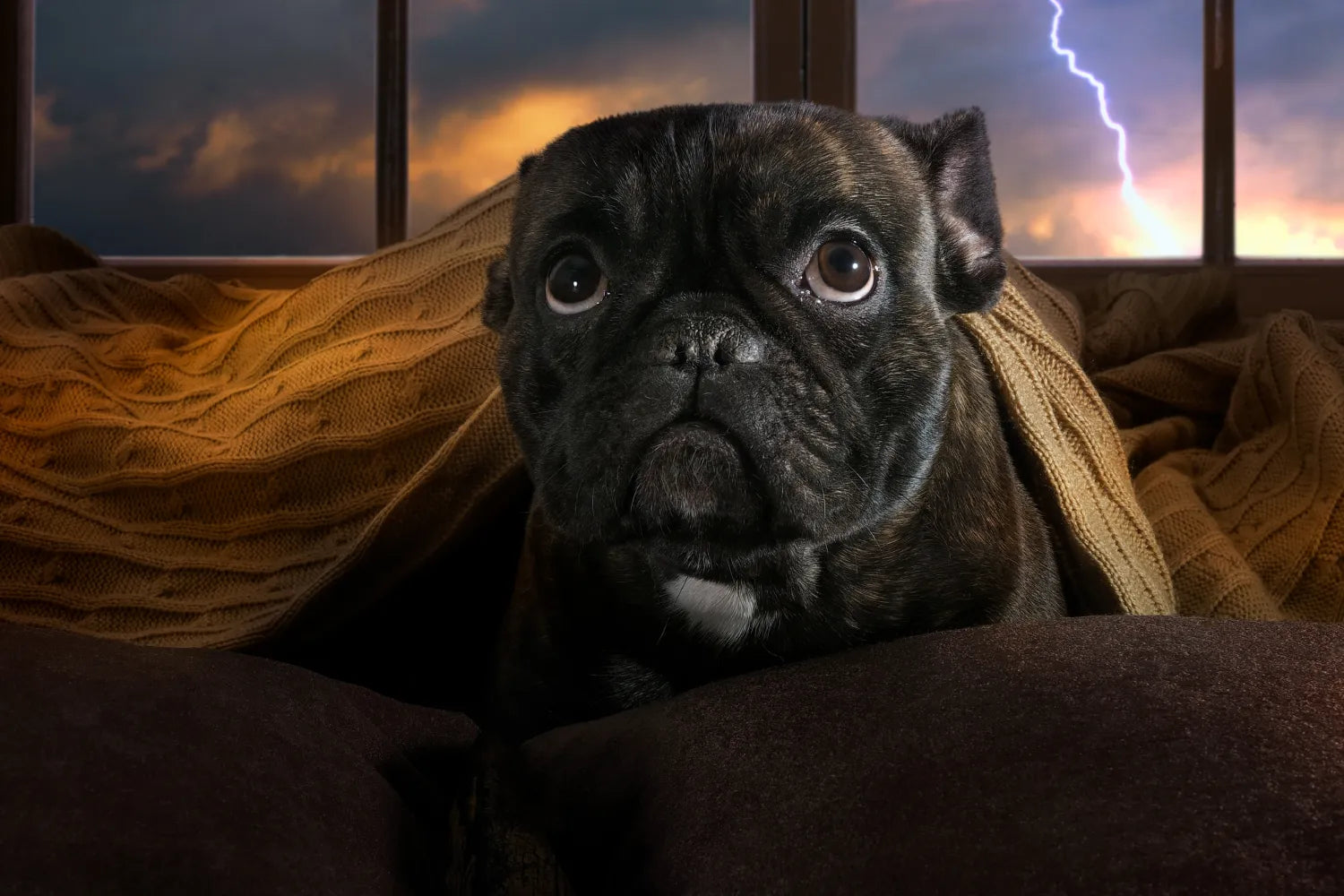Thunderstorm Anxiety in Dogs: A Complete Guide to Calming Your Pet During Storms
Thunderstorms can be awe-inspiring for humans, with their dramatic flashes of lightning and booming thunder. But for many dogs, these natural events are anything but magical. If your furry friend starts trembling, hiding, or pacing at the first rumble of thunder, you’re witnessing a common issue: thunderstorm anxiety in dogs. This fear can turn a cozy rainy day into a stressful ordeal for both you and your pet.
In this in-depth guide, we’ll explore why dogs fear thunderstorms, the science behind their anxiety, and the health and safety risks involved. We’ll also share real-life stories, common mistakes to avoid, and practical, vet-approved tips to help your dog stay calm during storms. Whether you’re dealing with a puppy’s first storm or a senior dog’s long-standing phobia, this article will give you the tools to make thunderstorms less frightening for your canine companion.

Table of Contents
- Why Do Dogs Fear Thunderstorms?
- The Science Behind Thunderstorm Anxiety in Dogs
- Health and Safety Risks During Thunderstorms
- Common Mistakes Pet Owners Make
- Real-Life Stories: Dogs and Thunderstorms
- Actionable Tips to Help Your Dog Stay Calm
- Recommended Products for Thunderstorm Anxiety
- Frequently Asked Questions About Thunderstorm Anxiety
- Final Thoughts
Why Do Dogs Fear Thunderstorms?
Thunderstorms are a perfect storm (pun intended) of sensory overload for dogs. The loud noises, bright flashes, and environmental changes can trigger intense fear. Let’s break down the key reasons why thunderstorms are so distressing for dogs.
Loud, Unpredictable Noises
Thunderclaps can reach decibel levels of 100–120 dB, comparable to a rock concert or chainsaw. Dogs, with their super-sensitive hearing, pick up these sounds at a much higher intensity than humans. Unlike predictable noises (like a doorbell), thunder is erratic, making it impossible for dogs to anticipate or prepare for the next boom.
Flashing Lights and Lightning
The sudden flashes of lightning can startle dogs, especially those with keen vision. Dogs can detect rapid changes in light, and the unpredictable flickering of a storm can be disorienting. For some dogs, lightning feels like a visual assault paired with the auditory chaos of thunder.
Atmospheric Changes
Dogs are highly sensitive to environmental shifts, such as changes in barometric pressure, humidity, or the smell of rain. These subtle cues often signal a storm before the first thunderclap, putting anxious dogs on edge well before the storm arrives.
Static Electricity
Some experts believe static electricity in the air during thunderstorms can contribute to canine anxiety. Dogs with thick fur may feel mild shocks or discomfort from static buildup, adding to their unease. This is particularly true for breeds with double coats, like Huskies or Malamutes.
Lack of Context
Dogs don’t understand that thunderstorms are natural, temporary events. To them, the loud noises and strange sensations mimic threats like predators or danger, triggering their survival instincts. Without the ability to rationalize the situation, their fear response kicks into overdrive.

The Science Behind Thunderstorm Anxiety in Dogs
Thunderstorm anxiety isn’t just a quirk—it’s rooted in a dog’s biology and psychology. Understanding the science can help you empathize with your pet and choose the best strategies to help them cope.
Canine Hearing and Sensory Overload
Dogs hear sounds at frequencies between 67 Hz and 45,000 Hz, far beyond the human range of 20 Hz to 20,000 Hz. Thunder, with its low-frequency rumbles and high-pitched cracks, falls within this range, making it overwhelming for dogs. The sound can also reverberate through their bodies, amplifying the sensation.
The Amygdala and Stress Response
When a dog hears thunder, their amygdala—the brain’s fear center—activates, releasing stress hormones like cortisol and adrenaline. This triggers the fight-or-flight response, causing behaviors like trembling, hiding, or trying to escape. For dogs with thunderstorm phobia, this response can be immediate and intense.
Conditioned Fear and Past Experiences
Some dogs develop thunderstorm anxiety due to negative past experiences. For example, a puppy startled by a loud storm may associate thunder with danger. Over time, this conditioned fear can worsen, causing anxiety at the first sign of a storm, like darkening skies or rain.
Breed and Personality Factors
Certain breeds, like herding dogs (e.g., Border Collies, Australian Shepherds) or hounds, are more prone to noise phobias due to their heightened alertness and sensitivity. Anxious or high-strung dogs are also more likely to develop thunderstorm anxiety, though any dog can be affected.
Static Shock Sensitivity
Research suggests that some dogs may experience discomfort from static electricity during storms. This can cause tingling or mild shocks, especially in dogs with long or thick fur. This physical sensation can exacerbate their fear, making storms feel like a multi-sensory threat.

Health and Safety Risks During Thunderstorms
Thunderstorm anxiety isn’t just distressing—it can pose serious risks to your dog’s health and safety. Here’s what you need to know to keep your pet safe.
Stress-Related Health Issues
Chronic stress from thunderstorms can weaken a dog’s immune system, leading to issues like digestive upset, loss of appetite, or increased susceptibility to illness. In severe cases, prolonged anxiety can contribute to heart problems or exacerbate existing conditions in older dogs.
Risk of Escape
Panicked dogs may try to flee during a storm, leading to a spike in lost pets during stormy seasons. The Humane Society notes that shelters often see an increase in stray dogs after thunderstorms. Escaped dogs risk getting lost, hit by cars, or encountering other dangers.
Injury from Panic
In their fear, dogs may injure themselves by scratching at doors, jumping through windows, or running into furniture. Some dogs chew destructively or hurt their paws while trying to dig their way to safety.
Long-Term Behavioral Changes
Untreated thunderstorm anxiety can lead to generalized noise phobias, where dogs become fearful of other loud sounds, like fireworks or vacuum cleaners. This can impact their quality of life and make everyday situations stressful.

Common Mistakes Pet Owners Make
Wanting to help your dog during a thunderstorm is natural, but some actions can unintentionally worsen their anxiety. Here are common mistakes and how to avoid them.
Over-Comforting Fearful Behavior
Petting or soothing your dog excessively when they’re scared can reinforce their fear. They may interpret your attention as confirmation that the storm is dangerous. Instead, stay calm and act as if the storm is no big deal.
Leaving Dogs Outside
Leaving your dog in the yard during a thunderstorm is risky. Even a secure fence may not stop a panicked dog from escaping. Always bring your dog indoors to a safe, quiet space.
Ignoring Early Signs of Stress
Many owners miss subtle signs of anxiety, like panting, pacing, or lip-licking, until their dog’s fear escalates. Addressing these early cues can prevent full-blown panic attacks.
Not Preparing in Advance
Waiting until the storm hits to take action can leave you and your dog unprepared. Setting up a safe space, consulting a vet, or starting desensitization training ahead of storm season can make a big difference.
Real-Life Stories: Dogs and Thunderstorms
These real-life examples show how thunderstorm anxiety affects dogs and what owners have done to help.
Case Study 1: Luna the Labrador
Luna, a 3-year-old Labrador, would shake and hide in the bathroom during thunderstorms. Her owner, Emily, tried comforting her with treats, but it didn’t help. After researching, Emily created a safe space in her closet with blankets and a white noise machine. She also used a Thundershirt and started desensitization training with storm sound recordings. By the next storm season, Luna was visibly calmer, spending storms napping instead of panicking.
Case Study 2: Rocky the Rescue
Rocky, a mixed-breed rescue, once broke through a screen door during a storm, running into the street. His owner, Mike, worked with a veterinary behaviorist to develop a calming routine, including pheromone diffusers and calming chews. Mike also installed a storm-proof crate for Rocky to retreat to. Now, Rocky stays relaxed during storms, curled up in his safe space with a chew toy.

Actionable Tips to Help Your Dog Stay Calm
Helping your dog cope with thunderstorm anxiety requires preparation and patience. Here are vet-approved strategies to ease their fear.
Create a Safe Haven
Designate a quiet, comfortable space where your dog can feel secure. This could be a crate covered with a blanket, a closet, or a room away from windows. Include their favorite toys, bed, and an item with your scent for comfort.
Use Sound Masking
Mask thunder with white noise machines, fans, or calming music. Playlists like “Through a Dog’s Ear” or classical music can soothe anxious dogs. Start the sound before the storm begins to create a calming environment.
Desensitization Training
Gradually expose your dog to storm sounds using recordings, starting at a low volume. Reward calm behavior with treats and slowly increase the volume over weeks. This can help your dog build tolerance to thunder.
Try Calming Aids
Products like Thundershirts, pheromone diffusers (e.g., Adaptil), or calming chews can reduce anxiety. Consult your vet before using supplements or medications to ensure they’re safe for your dog.
Exercise Before the Storm
A tired dog is less likely to be anxious. Take your dog for a long walk or play session earlier in the day, especially if a storm is forecasted. Avoid overexertion right before the storm, as it can increase stress.
Stay Calm and Present
Your dog takes cues from your behavior. Stay calm, speak softly, and avoid reacting to thunder. Your relaxed demeanor can help reassure your pet that there’s nothing to fear.
Secure Your Home
Close windows, doors, and curtains to muffle thunder and block lightning flashes. Ensure your dog’s collar has ID tags, and consider microchipping to prevent loss if they escape.
Address Static Electricity
If static shocks are an issue, try wiping your dog with a dryer sheet (unscented, pet-safe) or using a humidifier to reduce static in the air. Grounding your dog by letting them lie on a conductive surface, like a tile floor, can also help.
Recommended Products for Thunderstorm Anxiety
These vet-approved products can help ease your dog’s thunderstorm anxiety. Always consult your veterinarian before introducing new products.
- Thundershirt Classic Dog Anxiety Jacket: Applies gentle pressure to calm anxious dogs. Available at Chewy.
- Adaptil Calming Pheromone Diffuser: Releases calming pheromones to reduce stress. Available at Petco.
- Zesty Paws Calming Bites: Natural chews with chamomile and L-theanine. Available at Amazon.
- Through a Dog’s Ear Music: Calming music designed for dogs. Available on Spotify or Amazon.
- PetSafe Calming Puddle Duck Toy: A comforting toy with a heartbeat feature. Available at PetSafe.
Frequently Asked Questions About Thunderstorm Anxiety
Why is my dog afraid of thunderstorms?
Dogs fear thunderstorms due to loud noises, lightning flashes, atmospheric changes, and static electricity, which trigger their fight-or-flight response.
Can thunderstorms hurt my dog?
Thunderstorms are unlikely to cause physical harm, but the stress can lead to health issues, and panicked dogs may injure themselves or escape.
Should I medicate my dog for thunderstorm anxiety?
Medications should only be used under veterinary guidance. Non-invasive options like calming aids or training are often safer and effective.
How can I tell if my dog has thunderstorm anxiety?
Signs include trembling, hiding, panting, pacing, whining, or destructive behavior. Early cues like yawning or lip-licking indicate stress.
Can I train my dog to stop fearing thunderstorms?
Yes, desensitization training with storm sound recordings can reduce fear over time. Start with low volumes and reward calm behavior.
Final Thoughts
Thunderstorm anxiety in dogs can be heartbreaking to witness, but with the right knowledge and tools, you can help your pet feel safe and secure. By understanding the reasons behind their fear—sensitive hearing, atmospheric changes, and survival instincts—you can take proactive steps to ease their stress. From creating a cozy safe space to using calming aids and desensitization training, there are many ways to make storms less frightening.
Start preparing before storm season, avoid common mistakes like over-comforting, and consult your vet if your dog’s anxiety is severe. With patience and love, you can help your furry friend weather any storm. Have tips or stories about helping your dog during thunderstorms? Share them with the Cute Pets Lovers community in the comments!
